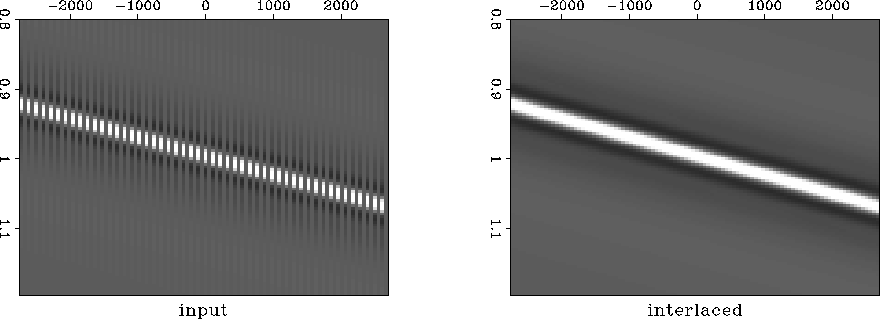![[*]](http://sepwww.stanford.edu/latex2html/cross_ref_motif.gif) fills in missing data at every other grid point by actually projecting
the model space p-
fills in missing data at every other grid point by actually projecting
the model space p-![[*]](http://sepwww.stanford.edu/latex2html/cross_ref_motif.gif) showed an example of an acquisition gap and its reconstruction.
Figure
showed an example of an acquisition gap and its reconstruction.
Figure ![[*]](http://sepwww.stanford.edu/latex2html/cross_ref_motif.gif) fills in missing traces by estimating the p-
fills in missing traces by estimating the p-
Interlacing a data set is equivalent to shifting to new location by
1/2 a gridpoint. This assumes a regular starting geometry.
Figure ![[*]](http://sepwww.stanford.edu/latex2html/cross_ref_motif.gif) fills in missing data at every other grid point by actually projecting
the model space p-
fills in missing data at every other grid point by actually projecting
the model space p-![]() onto a data geometry with twice as many traces.
Much more common than this data interlacing problem, is the need for filling
gaps in the data, due to trace editing or irregular acquisition. Figure
onto a data geometry with twice as many traces.
Much more common than this data interlacing problem, is the need for filling
gaps in the data, due to trace editing or irregular acquisition. Figure ![[*]](http://sepwww.stanford.edu/latex2html/cross_ref_motif.gif) showed an example of an acquisition gap and its reconstruction.
Figure
showed an example of an acquisition gap and its reconstruction.
Figure ![[*]](http://sepwww.stanford.edu/latex2html/cross_ref_motif.gif) fills in missing traces by estimating the p-
fills in missing traces by estimating the p-![]() domain in a least squares sense for the given geometry and then projecting
the model back onto the new geometry.
domain in a least squares sense for the given geometry and then projecting
the model back onto the new geometry.
 |